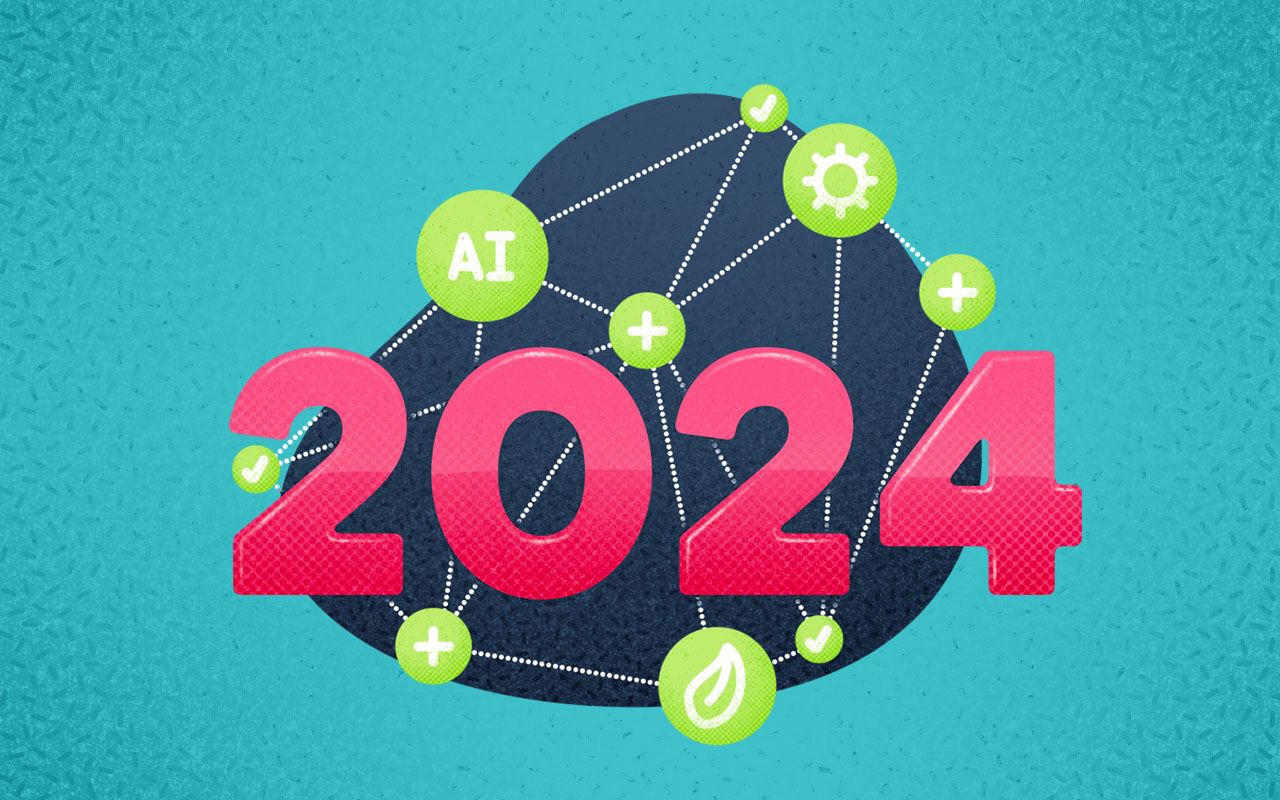This year (2023), the world saw LEGO Braille Bricks, the rise of Generative AI, OpenAI Dall-E 3, the biggest television screen on the planet, and an increase of needs and complexity in cybersecurity all make an appearance on newspaper headlines. There was no shortage of innovation and excitement, both within and outside of the technology industry. For the world of ITSM, there was immense growth in AI, workflows, automation, and case management.
Let’s explore what trends, both those based on pop culture and those backed by data, are the top IT trends for 2024.
Continued AI Adoption
This year, the word of the year was AI. Not because it’s new (it’s been around since the 1950s), but because the technology has finally reached a tipping point—user-facing utility and usability have gone exponential, with new high-value use cases gaining traction daily thanks to generative AI technologies. While companies have started to research the benefits of generative AI for their ITSM platforms or for their marketing, most haven’t fully begun to realize the benefits of the technology. 2024 will be the year most companies implement and include generative AI technology into their tools and solutions.
Emphasis on Digital Experience (DEX)
There’s an ever-increasing emphasis on employees (and for good reason). Not in paying them more money or adding to their benefits package (though that would be nice too), but in improving their training and enhancing the digital environments they use for work. With digital transformations and remote work becoming more prevalent, companies need to have great, streamlined digital experiences (DEX), or the entire organization will suffer—messages will get lost; employees will get frustrated; and software programs won’t integrate. The hope is that, in doing these things, there’s a culture change, increased communication, and more productivity among employees.
Digital Transformation
Digital transformation, the process of integrating digital technology and processes into all or parts of a business (getting rid of paper), are already happening in every industry. To the point that digital business is now just normal business. For 2024, the emphasis of digital transformation will be on increasing the percentage of companies who have implemented new technologies, and providing appropriate safety and security (see trend #5) to the digital immune system to prevent cyberattacks.
Automation
If technology exists to help you scale faster, save money, and reduce the number of errors from data being manually input into a spreadsheet, why not use it? That’s exactly what automation, the reduction of business tasks using technology, is aimed at doing. Automation software and extensions perform repetitive, time-consuming manual tasks for humans so they can focus on other, high-level items. By implementing automation into their processes, companies can work smarter – not harder.
Cybersecurity
Cybersecurity is one of the hottest areas in IT—one that will only continue to grow as an organizational risk, thus requiring more investment from companies moving forward. Generative cybersecurity AI and Cybersecurity mesh architecture (CSMA) were entered into the Gartner 2023 Hype Cycle, their predictions on 25 technologies that will significantly impact businesses in the next 10 years. These terms, along with exposure management, SOAR, and vulnerability prioritization technology show we’re only the beginning to grasp the influence of cybersecurity in ITSM. That said, customers already have some cybersecurity processes and technologies in place but are looking to reduce the number of vendors they use. More and more customers would rather have less vendors who do more, than a vendor for this, a vendor for that, and a vendor for that. Those who can condense their offerings and make the UX good will succeed.
Sustainability – Green IT
Technology usage and production isn’t going away…which means the greenhouse gases contributing to climate change aren’t either. The best solution? Green IT—investments in sustainable technology production, usage, and disposal. While sustainable IT practices are not typically first on the list for organizations, especially for smaller, cash-strapped organizations, (it’s usually: how to make $$) to figure out when starting their business, it’s something they need to consider if they want to be in the game in the long run. End-users’ care about how the products they use impact the environment. Make sure you invest in the right tools to help your business reduce your carbon footprint.
Reducing Technical Debt
Technical Debt (also known as code debt), the cost of having to rework code or technical aspects of the product, after choosing an easier solution, is complex. Doesn’t matter if its technical debt related to cybersecurity, digital transformation, or digital experience. The fact of the matter is, as more deadlines arise and the faster your business need to move, the more technical debt becomes an issue. To avoid operating a sinking ship through choppy waters, you need to invest in the right technology proactively. Requiring 1) allocating a portion of the budget to managing technical debt, and 2) improving system visibility into technical debt so you can find and solve for it.
Enterprise Service Management Strategies
In the era of digital business, IT has responded to pressures to be more in tune with business needs. One way to be a better business partner is by expanding technology offerings to include a platform that helps business partners build workflows for their teams – not just configuring servers, and endpoint devices, but also offering a platform that supports every level of the work being done (end-to-end management solution). Setting up enterprise service management (ESM) systems requires work—they are not just one and done. When done right though, they make a huge difference for both employers and customers, by making workflows and services across the business connect more seamlessly. But to get there, the services need to be defined, created, and improved…continuously. Questions to be answered: Who and what is going to be interacting with the parts of the business? How do the various parts need to communicate? What information do they need to know?
To help companies create robust ESM systems, there’s a push from ITSM vendors to build practical and tactical solutions, allowing companies to interchange the department solutions where and as needed—emphasizing the flexibility of the tool.
2024 will be a year of relentless prioritization.
AI and automation will reduce human touch.
DEX/DEM will increase human experience.
ESM will enable a seamless digital outcome.
Companies who succeed in 2024 and beyond will be the ones who harness the technology and strategies at their disposal to trim the fat (read: get rid of unnecessary processes and procedures) and invest in technology to increase the productivity, and speed at which they move.
Infographic – The status of SMB IT in 2026
Explore how AI, automation & integrated ITSM/ITAM are reshaping IT strategy—at every scale.


